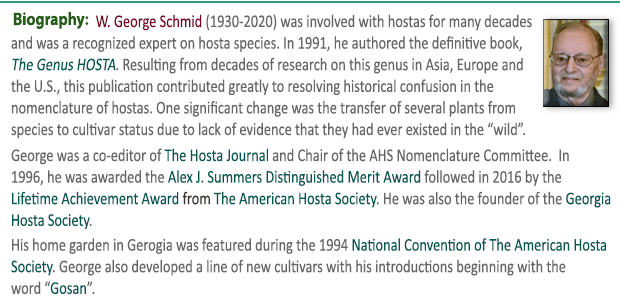|
 According to
The Genus Hosta by W. George Schmid (1991), as the name implies, it has a very
distinct, upright (erect) form to the clump. H. rectifolia is related to the
species H. sieboldii. According to
The Genus Hosta by W. George Schmid (1991), as the name implies, it has a very
distinct, upright (erect) form to the clump. H. rectifolia is related to the
species H. sieboldii.
 The glaucous leaves are
dark green to blue-green in color. It grows into a large size hosta about 24 inch high
by 70 inches wide. The leaves have stout petioles
and are lanceolate in shape, flat and have smooth texture. This species bears striped,
purple flowers with purple anthers from mid-August into September. There are short
green bracts on the flowers scapes. The glaucous leaves are
dark green to blue-green in color. It grows into a large size hosta about 24 inch high
by 70 inches wide. The leaves have stout petioles
and are lanceolate in shape, flat and have smooth texture. This species bears striped,
purple flowers with purple anthers from mid-August into September. There are short
green bracts on the flowers scapes.
 From the
Field Guide to Hostas by Mark Zilis (2014), "Many variegated forms of H. rectifolia exist, most found in the
wilds of Japan." From the
Field Guide to Hostas by Mark Zilis (2014), "Many variegated forms of H. rectifolia exist, most found in the
wilds of Japan."
The New Encyclopedia of Hostas by
Diana
Grenfell (2009) describes H.
rectifolia as: "A broad-spectrum species with many attractive
variegated forms not yet in commerce. The scapes are known to
tower over 7 ft. (2.1 m), a characteristic that could more often
be exploited in hybridizing programs."
 Mark Zilis' Field Guide to Hostas (2014)
states that this species was found in Japan in "...swamps;
wetlands; woodlands..." Mark Zilis' Field Guide to Hostas (2014)
states that this species was found in Japan in "...swamps;
wetlands; woodlands..."
Mikiko Lockwood in an article on The Hosta Library titled,
A Little About Japanese Hosta Terms defines the term tachi as upright, 'Tachi Gibōshi' or
H. rectifolia.

 |



